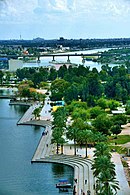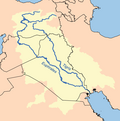Kadhimiya
ٱلْكَاظِمِيَّة ٱلْكَاظِمَيْن el-Kâzımiyye el-Kâzımeyn | |
|---|---|
Neighbourhood | |
 View of the mosque and its environs | |
| Coordinates: 33°22′50″N 44°20′50″E / 33.38056°N 44.34722°E | |
| Country | |
| Governorate | Baghdad |
| District | Kāẓimiyyah |
| Area | |
| • Total | 28 km2 (11 sq mi) |
| Population (2013) | |
| • Total | 1,500,000 |
| Time zone | UTC+3 (AST) |
Kadhimiya (Arabic: ٱلْكَاظِمِيَّة, romanized: el-Kâzımiyye, pronounced [alˈkaːðˤɪmijːa]) or Kadhimayn (ٱلْكَاظِمَيْن, el-Kâzımeyn) is a northern neighbourhood of the city of Baghdad, Iraq. It is about 5 kilometres (3.1 mi) from the city's center, on the west bank of the Tigris. 'Kadhimiya' is also the name of one of nine administrative districts in Baghdad. As the place of al-Kadhimiya Mosque, even before its inception into the urban area of Baghdad, it is regarded as a holy city by Twelver Shia muslims.[1]





